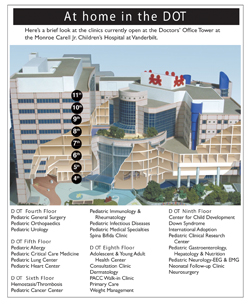
Report tracks kidney transplant survival rates
Vanderbilt University Medical Center's kidney transplant outcomes are significantly higher than the national average, according to a recent report of the Scientific Registry of Transplant Recipients (SRTR).
Every six months, a report on activities of every transplant center and procurement agency in the nation is released by the SRTR, which supports ongoing evaluation of the scientific and clinical status of solid organ transplantation, including kidney, pancreas, liver, intestine, heart, lung and heart-lung. The group designs and implements scientific analyses of data and distributes the information to the transplant community.
The July report states that the graft survival for adult kidney patients transplanted at Vanderbilt is 95 percent — the national percentage is 91.
“We are thrilled with that,” said J. Harold Helderman, M.D., professor of Medicine, Microbiology and Immunology and assistant dean of Medical School Admissions. “That number is even better than what was expected for Vanderbilt, which was 92 percent.
“Every center in the nation thinks it is doing a great job,” he said. “And prior to these reports, the data circulated would often be misconstrued, which confused consumers. In the past, no one could prove their outcome data. Now each transplant program is required by federal law to report all of its outcome data. It's all out there.”
The report gives a center-by-center evaluation of transplant outcomes. Although Vanderbilt's Transplant Program also includes the Veterans Hospital, the numbers used in this report are separate.
David Shaffer, M.D., professor of Surgery and chief of the Division of Kidney and Pancreas Transplantation, said the numbers from the national database are a combination of multiple factors used to determine each hospital's expected outcomes. Such information includes the age of donor and recipient, type of renal disease, length of dialysis use, blood type, etc.
“As a general observation, to get a significantly better one-year graft and patient survival is a product of a multi-disciplinary team effort, careful patient selection, excellent technical results from the surgery itself as well as superlative pre-operative and post-operative care.
“You need all the components working well to get a good long-term graft and patient survival. This is a reflection of our excellent hospital and clinic care. It is a programmatic effort that involves all levels of care and coordination,” Shaffer said.
Here is a breakdown of the data:
From January 2002 to June 2004, Vanderbilt performed 244 kidney transplants. The patient survival for one year was 99.5 percent, higher than the expected percentage for Vanderbilt, which was 96.7 percent. The national average was 96 percent.
Other benchmarks for Vanderbilt include: a steady acute rejection rate of 7 percent; hospital length of stay, readmission rates for complication and rejection rates were among the best, which put the Medical Center in the top 10 percentile in the country.
“In the last two and a half years, our patient survival in the first year is 99.5,” Helderman said. “That means that we lost only one patient during that time. In our pediatric program, we have no losses.”
The graft survival rate for pediatric patients is 100 percent in this time frame. The national percentage is 95 percent.
“The excellent graft survival is the result of excellent multidisciplinary care in the hospital and the clinic,” said Kathy Jabs, M.D., director of Pediatric Nephrology. “After the patient discharge from the hospital, the patients and parents are very important members of that team and play important roles in successful outcomes.”
In 2000, Vanderbilt performed 58 kidney transplants. Those numbers rose to 100 in 2003 and 110 in 2004. In the first nine months of 2005, Vanderbilt has done 100 transplants, including six pediatric cases, putting it on target to do more than 120 for the year.
There have been 14 children transplanted since the pediatric program moved to the Monroe Carell Jr. Children's Hospital at Vanderbilt in February 2004.
“These are things that we are very proud of. We are doing more transplants and working hard at recruiting and marketing our program. We are trying to make sure the public knows that this is one of the premier programs in terms of outcomes,” Helderman said.
The VA recorded 19 kidney transplants in 2004 and during the first nine months of 2005 there were 25. That puts the total number of kidney transplants performed under the Vanderbilt Transplant Program at 129 in 2004.
In 2004 the state of Tennessee reported 324 kidney transplants, with Vanderbilt performing 129. Vanderbilt performs 40 percent of all kidney transplants in the state and is the major provider in the city as well.













